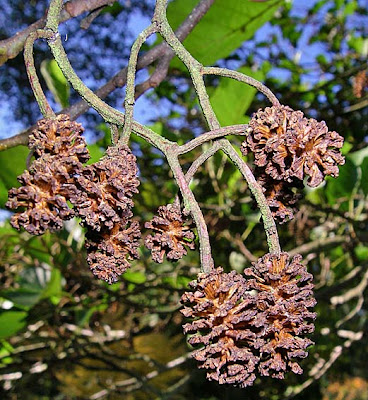This little huddle of 7-spot ladybirds, apparently settling down for communal hibernation, were a bit premature in their choice of these unripe alder Alnus glutinosa cones as a resting place last week. Within a few days the cones will begin to ripen ....
... become woody and spit open. You can just see the tiny chestnut-brown seeds inside. They are an important food source for many birds in winter and are released in vast numbers from now until January. The tree will be flowering again in February and you can see next year's embryonic cones already formed - they are the little knobbly things on stalks, top left, next to the bud at the tip of the shoot. Above the ripening cones you can also see next spring's male catkins already forming.
Alder cones tend to stay attached to the tree for a long time - these old ones would have shed their seeds back in October-November 2009.
Ever since grey squirrels moved into my part of Durham it has become harder to find fully ripe hazel Corylus avellana nuts - the squirrels take them while they are still at this green stage. Filberts are cultivated hazels that have much longer leafy bracts sheathing the nuts.
Wild cherry or gean Prunus avium fruit ripens in July. A couple of years ago I did a taste test on as many different fruit-bearing wild cherry trees as I could find. They were surprisingly variable - most were breathtakingly sour but a few were sweet enough to eat. The hard seed inside the fruit is a favourite food of hawfinches - one of the few birds with a beak that's powerful enough to crack it open. Everytime I see a tree in fruit I scan the ground below for a hawfinch eating the seeds from rotting fruits: no luck so far but I live in hope...... The hard cherry stones are also popular with field mice. When I demolished our old garden shed I found a mouse's stash of scores of cherry stones from the tree that used to grow in our garden hedge, each with a neat hollow nibbled in it.
Professional foresters can identify conifers just by crushing their needles and sniffing their resinous aroma. This is one of the easier ones for scratch-and-sniff botany - Western Hemlock Tsuga heterophylla (which is not related to the hemlock that poisoned Socorates). Apart from the hint of citrus scent in its resin (some say it smells like ground elder), it bears these small purplis cones and the shoots carry needles of varying lengths. It's a native of the west coast of North America, but often seen in forestry plantations in Britain, especially on the wetter western side.
For more posts on tree ID click here





























Very interesting to read your posts. I wish I knew how to identify the native trees here.
ReplyDeleteAgain, I have learned something, thank you. I was out for a walk today and saw so many Ladybirds.
ReplyDeleteI guess you have many more species than us lotusleaf, so it would be a tougher task...?
ReplyDeleteIt seems to have been a good summer for labybirds Toffeeapple, and they're quite conspicuous when they cluster together to hibernate - they like the dry shelter of my leylandii hedge..
ReplyDelete